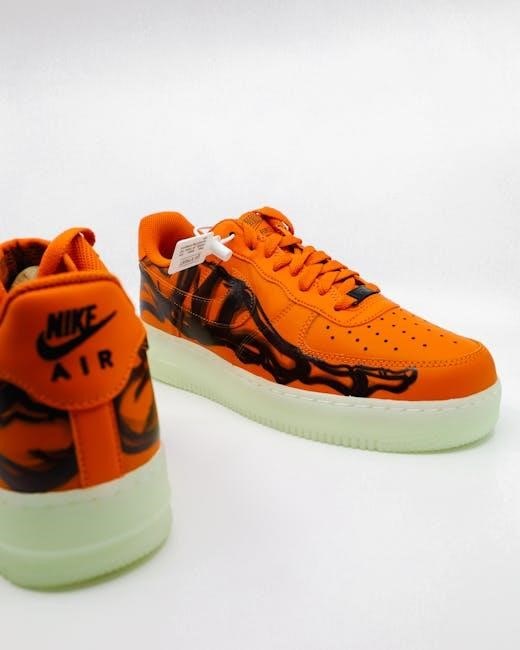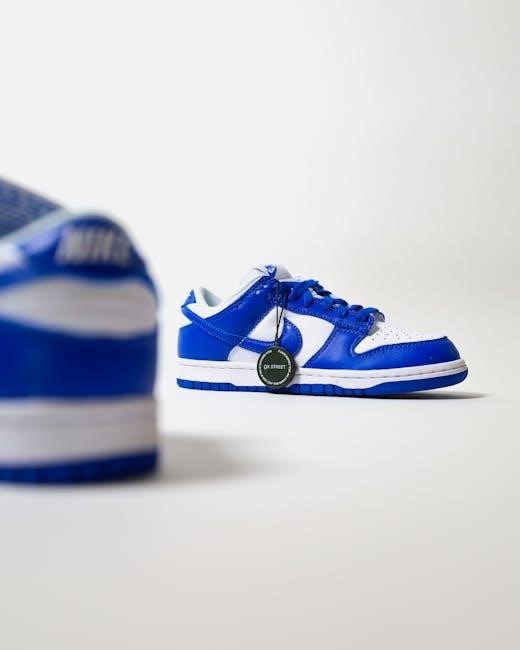Nike tags are essential for identifying authenticity, dating products, and understanding their history․ From vintage labels to modern designs, these tags provide vital information for collectors and enthusiasts․

Overview of Nike Tags and Their Importance
Nike tags are crucial for verifying authenticity, dating products, and understanding the brand’s evolution․ They provide detailed information about production, sizing, and style codes, helping collectors and enthusiasts identify genuine items․ Tags also reveal historical design changes, such as the iconic Pinwheel and Orange Labels, which are sought after by vintage collectors․ Additionally, modern tags incorporate advanced features like digital integration for authentication․ These labels serve as a bridge between the brand’s heritage and contemporary innovations, ensuring transparency and trust for consumers․ By analyzing Nike tags, one can trace the journey of a product, from its manufacturing date to its current state, making them indispensable for both enthusiasts and resellers․
Historical Background of Nike Tags
Nike tags have evolved significantly since the brand’s inception in 1964․ The first labels, introduced in the 1970s, featured simple designs with minimal information․ The iconic Pinwheel Label, debuting in 1978, marked a turning point, becoming synonymous with vintage Nike apparel․ Concurrently, the Orange Label emerged, distinguishing higher-quality products․ These early tags laid the foundation for modern labeling practices․ Over the decades, Nike incorporated wash-tags, size labels, and production codes, enhancing transparency and authenticity․ The 1990s brought a shift to more streamlined designs, while the 2000s introduced contemporary styles with advanced materials․ Today, Nike tags blend heritage elements with cutting-edge technology, reflecting the brand’s commitment to innovation and quality․ This historical progression underscores the importance of tags in tracing Nike’s journey and preserving its legacy․

Key Types of Nike Tags
Nike tags include Pinwheel, Orange, wash-tags, size, and production labels, each reflecting the brand’s evolution and aiding in product authentication and historical identification․
Nike Pinwheel Label (1978-1982)
The Nike Pinwheel Label, used from 1978 to 1982, is a distinctive marker of early Nike apparel․ Primarily found on tees, sweatshirts, and jackets, this label features a unique circular design with the Nike swoosh and text arranged in a pinwheel pattern․ It is highly sought after by vintage collectors for its nostalgic appeal and historical significance․ The Pinwheel Label helps enthusiasts date items from this era and verify authenticity․ Its design reflects Nike’s early branding efforts, making it a key element in identifying vintage gear․ Collectors often use this label to trace the origins of their items, as it represents a pivotal period in Nike’s evolution․
Nike Orange Label (1978-1983)
The Nike Orange Label, active from 1978 to 1983, is another iconic marker of the brand’s early years․ Commonly found on tees, sweatshirts, jackets, and shoes, this label features a vivid orange background with the Nike swoosh and text․ It served as a key identifier for Nike products during this period and is cherished by vintage enthusiasts․ The Orange Label helps in dating items and verifying authenticity, offering insight into Nike’s evolving branding strategies․ Collectors value this label for its vibrant design and historical significance, making it a crucial element in the world of vintage Nike apparel and footwear․
Nike Wash-Tag Evolution
The Nike wash-tag has undergone significant changes over the years, serving as a crucial element for identifying and dating Nike apparel․ From the 1970s onward, these tags have evolved in design, material, and the information they provide․ Early tags were simpler, often featuring basic care instructions, while modern versions include detailed information such as fabric composition, sizing, and even QR codes for authentication․ The 1980s saw the introduction of more vibrant colors and specific symbols, while the 1990s brought about tags with global care symbols․ Today, wash-tags are integral to verifying authenticity and understanding production details, making them a key focus for collectors and enthusiasts alike․ Their evolution reflects Nike’s commitment to innovation and transparency in its products․
Nike Size and Production Labels
Nike size and production labels are critical for verifying authenticity and understanding the manufacturing details of Nike products․ These labels typically include the size, style code (SKU), and production dates, providing valuable information for collectors and enthusiasts․ Modern Nike footwear labels often feature a detailed breakdown of production specifics, while apparel labels may include fabric composition and care instructions․ Over the years, these labels have become more sophisticated, incorporating additional details such as country of origin and quality control codes․ By examining these labels, consumers can ensure they are purchasing genuine Nike products and gain insight into the item’s history․ For vintage items, these labels can help date the product and verify its legitimacy, making them an essential tool for authentication and collection curation․

Nike Tag Guide by Decade
Nike tags have evolved significantly over the decades, reflecting design trends and authentication methods․ Each era offers unique labeling styles, from vintage Pinwheel tags to modern digital integrations․
1970s: The Birth of Nike Labels
The 1970s marked the beginning of Nike’s labeling journey, introducing simple yet distinctive tags that reflected the brand’s early identity․ These labels were minimalistic, often featuring the Nike name and basic product information like “Made in USA․” The decade saw the emergence of the iconic Pinwheel and Orange labels, which became synonymous with vintage Nike apparel․ These early tags were small, durable, and sewn into garments, serving both functional and branding purposes․ Collectors today prize these labels for their historical significance and rarity․ The 1970s laid the foundation for Nike’s labeling system, which would evolve over the decades to include more detailed production codes and authentication features․
1980s: The Rise of the Pinwheel and Orange Labels
The 1980s witnessed the rise of two iconic Nike labels: the Pinwheel and Orange tags․ The Pinwheel label, introduced in 1978 and used until 1982, featured a distinctive circular design with the Nike swoosh at its center, symbolizing motion and energy․ This label became a hallmark of vintage Nike apparel, often found on T-shirts, sweatshirts, and jackets․ Concurrently, the Orange label, used from 1978 to 1983, showcased a bold orange background with black text, adding a vibrant touch to Nike’s branding․ Both labels were widely used across various products, including footwear, and are now highly sought after by collectors for their retro appeal and historical significance․ These designs reflected Nike’s growing brand identity and laid the groundwork for future label innovations․
1990s: The Era of Modern Tags
The 1990s marked a significant evolution in Nike tags, introducing modern designs that prioritized clarity and functionality․ This decade saw the widespread use of size and production labels, which included detailed information such as size codes, style numbers (SKU), and production dates․ These tags became more standardized, making it easier for consumers to identify authentic products․ Additionally, the inclusion of care instructions in multiple languages reflected Nike’s growing global presence․ The 1990s also introduced vibrant colors and bold typography, enhancing the visual appeal of the tags․ This era laid the foundation for contemporary label designs, blending practicality with brand identity․ Collectors often prize tags from this period for their nostalgic value and historical significance in Nike’s journey toward becoming a global sportswear leader․
2000s: Contemporary Label Designs

The 2000s saw Nike tags embrace modernity with sleek, minimalist designs․ This era introduced bold color schemes and clean typography, making tags more visually appealing․ Size and production labels became more detailed, often featuring style codes and production dates to enhance authenticity․ The use of digital printing allowed for intricate designs and sharper text․ Tags from this period also incorporated care instructions in multiple languages, reflecting Nike’s global reach․ The 2000s marked a shift toward eco-friendly materials, with some tags highlighting sustainable practices․ Additionally, this decade introduced QR codes on select tags, linking consumers to product information online․ These advancements solidified Nike’s commitment to innovation while maintaining the brand’s iconic identity․ Collectors appreciate the blend of functionality and aesthetics in these contemporary designs․
2010s: Digital Integration in Tags
The 2010s marked a significant evolution in Nike tags with the integration of digital technology․ QR codes became a common feature, allowing consumers to scan tags for product information, care instructions, and authenticity verification․ This decade also saw the introduction of RFID tags in footwear, enhancing supply chain tracking and inventory management․ Digital labeling enabled Nike to incorporate dynamic content, such as customizable messages and campaign-specific designs․ The use of digital platforms for tag verification rose, helping combat counterfeits․ Additionally, Nike began exploring eco-friendly materials for tags, aligning with sustainability goals․ These advancements not only improved functionality but also enhanced the consumer experience, making tags more interactive and informative․ This era laid the foundation for future innovations in tag technology and authentication methods, ensuring Nike stayed ahead in the industry․

2020s: Advanced Labeling and Authentication
The 2020s saw Nike embrace cutting-edge technology in tag design, focusing on enhanced authentication and sustainability․ QR codes became more prevalent, linking to detailed product information, care instructions, and brand storytelling․ RFID tags were further refined for improved inventory tracking and consumer engagement․ Nike also introduced tamper-evident holograms and unique serial numbers to combat counterfeiting․ Eco-conscious efforts led to the use of recycled materials in labels, aligning with global sustainability trends․ Additionally, the decade witnessed the rise of digital verification platforms, enabling consumers to authenticate products instantly․ These advancements not only elevated the functionality of Nike tags but also strengthened brand trust․ By combining innovation with environmental responsibility, Nike continues to set new standards in labeling and authentication, ensuring a seamless and secure experience for customers worldwide․

How to Authenticate Nike Products Using Tags
Examine label details, compare with authentic examples, and check for consistency in logos, fonts, and production codes․ Verify using trusted platforms and guides to ensure authenticity․
Step-by-Step Guide to Spotting Fake Tags
To spot fake Nike tags, start by examining the label’s font and color consistency․ Authentic tags typically feature sharp, precise text and vibrant colors․ Check for mismatched logos or uneven spacing, as counterfeit tags often lack attention to detail․ Compare the tag with official examples from trusted sources or guides․ Look for production codes and sizing labels, ensuring they align with Nike’s standard formats․ Verify the era-specific designs, such as the Orange Label (1978-1983) or Pinwheel Label (1978-1982), to ensure accuracy․ Finally, use trusted platforms like StockX or The RealReal for authentication; These steps help identify genuine Nike products and avoid counterfeit items․
Comparing Authentic vs․ Counterfeit Labels
Authentic Nike labels exhibit crisp, well-defined text and precise logo placement, while counterfeit tags often appear blurry or misaligned․ Genuine tags feature consistent color schemes, with vibrant hues that align with Nike’s branding․ Counterfeit labels may have faded or mismatched colors․ Examine the production codes and sizing information, as authentic tags include specific details like style codes (SKU) and production dates․ Counterfeit tags may lack these details or display inaccurate information․ Additionally, authentic labels from specific eras, such as the Orange Label (1978-1983) or Pinwheel Label (1978-1982), showcase unique designs that counterfeit tags often replicate poorly․ By comparing these elements, enthusiasts can better distinguish genuine Nike tags from fake ones․
Using Trusted Platforms for Verification
Trusted platforms like The RealReal, Grailed, and Vestiaire Collective are invaluable for verifying Nike tags․ These sites employ experts to authenticate products, ensuring labels are genuine․ StockX is another reliable option, known for its rigorous authentication process․ By using these platforms, collectors and buyers can confirm the legitimacy of Nike tags and gain peace of mind․ Additionally, online forums and communities dedicated to vintage Nike enthusiasts provide resources and guides for cross-referencing tags․ These platforms not only help in authentication but also preserve the value and authenticity of Nike products․ For those seeking to buy or sell vintage Nike items, trusted platforms are essential for maintaining credibility and ensuring transactions are secure and reliable․

Nike Tags on Specific Products
Nike tags vary across products, with vintage t-shirts featuring iconic labels like the Pinwheel and Orange tags, while sweatshirts and footwear include detailed size and production information․
Vintage Nike T-Shirts: Identifying Authentic Tags
Vintage Nike t-shirts often feature iconic labels like the Pinwheel and Orange tags, which are crucial for authenticity․ The Pinwheel Label (1978-1982) is a rare and sought-after tag, while the Orange Label (1978-1983) is commonly found on vintage tees․ These tags can be identified by their distinct designs and color schemes․ Authentic tags typically have vibrant colors, precise stitching, and consistent fonts․ Counterfeit tags may appear faded or have uneven lettering․ Collectors should also look for the presence of a “Made in USA” stamp, as many vintage Nike t-shirts were produced domestically․ Additionally, the placement of the tag—usually on the inside collar or hem—can help verify authenticity․ By examining these details, enthusiasts can confidently identify genuine vintage Nike t-shirts and avoid replicas․
Nike Crewneck Sweatshirts: Label Analysis
Nike crewneck sweatshirts from the late 1970s to the early 1980s often feature the iconic Pinwheel and Orange labels․ The Pinwheel Label, used from 1978 to 1982, is a circular tag with a spinning wheel design, symbolizing motion and energy․ The Orange Label, active from 1978 to 1983, is a rectangular tag with bold orange coloring and black text, signifying high-quality materials․ Both labels are typically found on the inside collar or hem of the sweatshirt․ Authentic tags display crisp, vibrant colors and precise stitching․ Counterfeit tags may lack the same level of detail or color consistency․ Collectors and enthusiasts use these labels to verify the authenticity and age of vintage Nike crewneck sweatshirts, making them invaluable for identifying genuine pieces from this era․
Nike Footwear: Understanding Size and Production Tags
Nike footwear tags are crucial for determining size, production details, and authenticity․ Modern Nike shoes feature a size label inside the shoe or on the box, displaying the size, style code (SKU), and production date․ Vintage models, particularly those from the 1970s and 1980s, often have simpler labels with less detailed information․ Authentic tags are typically made of durable materials with precise printing․ Counterfeit tags may have blurry text or incorrect formatting․ Collectors use these tags to verify the shoe’s authenticity and trace its production history․ Additionally, the style code can be cross-referenced with official Nike catalogs or trusted platforms like StockX to confirm legitimacy․ Understanding these tags is essential for both collectors and enthusiasts seeking genuine Nike footwear, ensuring their purchases are authentic and accurately dated․

Nike Tag Resources and Guides
Online communities and forums offer valuable resources for Nike enthusiasts, providing infographics, guides, and trusted platforms to date and authenticate Nike products effectively․
Online Communities and Forums for Nike Enthusiasts
Online communities and forums are invaluable for Nike enthusiasts, offering a wealth of knowledge on tags, labels, and authentication․ Platforms like Reddit, Facebook groups, and specialized sneaker forums provide spaces for collectors to share insights and verify the authenticity of Nike products․ Trusted platforms such as The RealReal, Grailed, and Vestiaire Collective are often recommended for buying and selling vintage Nike items․ Additionally, forums like Sneaker News and Nike Talk feature discussions on historical tags, such as the Nike Pinwheel Label and Orange Label, helping enthusiasts date and identify their gear․ These communities also share infographics and visual guides, making it easier for newcomers to navigate the world of vintage Nike tags and labels․
Infographics and Visual Guides for Dating Nike Gear
Infographics and visual guides are powerful tools for dating Nike gear, offering a clear and concise way to identify authentic tags and labels․ These resources often feature timelines, color palettes, and logo evolutions, helping enthusiasts pinpoint the era of their Nike items․ Many creators share detailed charts on platforms like Pinterest and Instagram, breaking down decades of Nike tag designs․ For example, guides highlight the distinctive Nike Pinwheel Label of the late 1970s and early 1980s, as well as the Orange Label that followed․ Visual guides also explain how to decode production codes and size labels, making the authentication process more accessible․ These resources are particularly useful for newcomers to vintage collecting, providing a straightforward way to understand the history behind Nike tags and labels․
Recommended Platforms for Buying and Selling Vintage Nike
For enthusiasts seeking authentic vintage Nike items, trusted platforms like The RealReal, Grailed, and Vestiaire Collective are highly recommended․ These sites specialize in verified luxury and vintage goods, ensuring authenticity․ StockX is another reliable option, particularly for sneakers, as it offers a detailed authentication process․ Additionally, eBay and Etsy host a wide range of vintage Nike listings, including rare items like 1970s Pinwheel and Orange Label apparel․ For casual buyers and sellers, Facebook Marketplace and local vintage stores provide accessible avenues․ Online communities on Pinterest and Instagram also serve as hubs for inspiration and connecting with sellers․ These platforms collectively cater to both collectors and casual buyers, making vintage Nike gear more accessible than ever․

Care and Maintenance of Nike Tags
To preserve Nike tags, clean them gently with a damp cloth and avoid harsh chemicals․ Store in a cool, dry place to prevent fading and damage․
Preserving Vintage Labels for Longevity
Preserving vintage Nike labels requires delicate care to maintain their integrity and value․ Avoid exposing tags to direct sunlight, as it can cause fading and discoloration․ Gently clean labels with a soft, damp cloth, steering clear of harsh chemicals or abrasive materials that might damage the fabric or inks․ For storage, place the items in acid-free tissue paper or archival-quality containers to prevent moisture and dust buildup․ Avoid folding or creasing the labels, as this can lead to wear over time․ Professional conservation methods, such as encapsulation, can also be considered for especially rare or fragile tags․ Regularly inspect labels for signs of deterioration and address issues promptly to ensure their longevity․ Proper preservation not only maintains the aesthetic appeal but also retains the historical significance of vintage Nike labels, making them cherished possessions for collectors and enthusiasts alike․
Cleaning and Storage Tips for Nike Tags
Proper cleaning and storage are crucial for maintaining the condition of Nike tags․ For cleaning, use a soft, dry cloth to gently remove surface dirt․ Avoid harsh chemicals or abrasive materials, as they can damage the fabric or ink․ For stubborn stains, dampen the cloth with distilled water and mild soap, but avoid soaking the label․ Air-dry the tag naturally, away from direct sunlight․ For storage, place items in acid-free tissue paper or archival-quality boxes to prevent moisture and dust․ Store in a cool, dry environment, avoiding extreme temperatures․ Consider using protective sleeves for tags on garments to prevent friction and wear․ Regularly inspect stored items for signs of deterioration․ By following these steps, you can ensure the longevity and integrity of your Nike tags, preserving their value for years to come․
Nike tags are vital for authenticity, dating, and understanding product history, serving as a bridge between heritage and innovation for collectors and enthusiasts alike․
Final Thoughts on Nike Tags and Their Significance
Nike tags hold immense significance as they encapsulate the brand’s evolution, from iconic designs like the Pinwheel and Orange labels to modern, tech-integrated tags․ These labels are not just markers of authenticity but also chronological milestones, allowing collectors and enthusiasts to trace the journey of Nike’s products over decades․ The detailed information embedded in these tags, such as production dates, sizes, and style codes, serves as a vital resource for verifying the legitimacy of items․ Moreover, the community-driven guides and platforms dedicated to Nike tags highlight their importance in fostering a culture of appreciation for vintage and contemporary gear alike․ Thus, Nike tags are integral to both the brand’s legacy and the passion of its followers․
Future of Nike Labeling and Authentication
The future of Nike labeling and authentication lies in innovation and technology․ As counterfeit threats evolve, Nike is expected to integrate advanced digital elements, such as QR codes linked to product databases, ensuring authenticity verification․ Sustainable materials and eco-friendly labeling practices may also become standard, aligning with global environmental trends․ Additionally, the rise of digital platforms and AI-driven tools will enhance the ability to trace and verify Nike products, making the process faster and more accurate․ Collectors and enthusiasts can expect more detailed labeling, including production history and design inspiration, further enriching the storytelling behind each item․ Trusted platforms like StockX and The RealReal will continue to play a crucial role in verifying authenticity, ensuring a seamless experience for buyers and sellers alike․
